
Callichthyidae is a family of catfishes, called armored catfishes due to the two rows of bony plates along the lengths of their bodies. It contains some of the most popular freshwater aquarium fish, such as many species in the genus Corydoras.

Loricariidae is the largest family of catfish, with 92 genera and just over 680 species. Loricariids originate from freshwater habitats of Costa Rica, Panama, and tropical and subtropical South America. These fish are noted for the bony plates covering their bodies and their suckermouths. Several genera are sold as "plecos", notably the suckermouth catfish, Hypostomus plecostomus, and are popular as aquarium fish.

Trichomycteridae is a family of catfishes commonly known as pencil catfishes or parasitic catfishes. This family includes the candiru fish, feared by some people for its alleged habit of entering into the urethra of humans. They are one of the few parasitic chordates. Another species is the life monsefuano which was important to the Moche culture and still an important part of Peruvian cuisine.
Listrura is a genus of pencil catfishes native to South America.

The loach catfishes are a family, Amphiliidae, of catfishes. They are widespread in tropical Africa, but are most common in streams at high elevations; most species are able to cling to rocks in fast-flowing streams. The 13 genera contain 68 species.

Trichomycterus is a genus of fish in the family Trichomycteridae, the largest genus of its family with over 170 species currently described. This genus is native to freshwater habitats in Central and South America. These fish are generally small, usually about 5 to 15 cm (2–6 in) in standard length, although the largest, T. rivulatus, can reach more than twice this size. Species differ from one another primarily in body proportions, fin ray counts and colouration. Despite their relatively small size, some, such as T. punctulatus, support fisheries and are important in the local cuisine.

The Heptapteridae, or three-barbeled catfishes, are a family of catfish that originate from the Americas. Most species are restricted to South America, but Imparfinis lineatus, Nemuroglanis panamensis and Pimelodella chagresi are native to Panama, and Rhamdia species occur as far north as Mexico. The name Heptapteridae is derived from Greek, hepta meaning seven and pteron meaning fin.

Loricarioidea is a superfamily of catfishes. It contains the six families Trichomycteridae, Nematogenyiidae, Callichthyidae, Scoloplacidae, Astroblepidae, and Loricariidae. Some schemes also include Amphiliidae. This superfamily, including Amphiliidae, includes about 156 genera and 1,187 species.
Neoplecostominae is a subfamily of South American catfishes of the family Loricariidae. Species of this subfamily live in high-mountain and swift-flowing river habitats.

Parotocinclus is a genus of fish in the family Loricariidae native to South America. This genus is distributed through almost all hydrographic systems in South America from the Guyana Shield drainages and Amazon Shield tributaries to the coastal drainages of eastern and southeastern Brazil, including the rio São Francisco basin. Most species have the caudal peduncle oval in cross section. It has been found that Characidium species may interact with P. maculicauda. The small Characidium will follow grazing P. maculicauda, which release particulate matter dislodged from the catfish's foraging.
Glaphyropoma is a genus of small pencil catfishes native to Bahia in Brazil.
Stauroglanis gouldingi is a species of catfish of the family Trichomycteridae, and the only species of the genus Stauroglanis.
Ammoglanis is a genus of pencil catfishes native to South America.
The Glanapteryginae are a subfamily of catfishes of the family Trichomycteridae. It includes four genera, Glanapteryx, Listrura, Pygidianops, and Typhlobelus.
The Sarcoglanidinae are a subfamily of catfishes of the family Trichomycteridae. It includes six genera: Ammoglanis, Malacoglanis, Microcambeva, Sarcoglanis, Stauroglanis, and Stenolicmus.

Ituglanis is a genus of small freshwater fish in the family Trichomycteridae native to South America. Their greatest diversity seems to occur in the Amazon River basin. Most species inhabit leaf litter, with several species living in caves.

The Trichomycterinae are a subfamily of catfishes of the family Trichomycteridae. It includes six genera, Bullockia, Hatcheria, Rhizosomichthys, and Eremophilus, all monotypic, Silvinichthys with seven species, and Trichomycterus, with over 170 species. The former five genera are diagnosed by putatively apomorphic characters, whereas Trichomycterus is defined by the lack of those specializations and is likely not monophyletic. This subfamily has historically served as much of a wastebasket for trichomycterids that lack the specializations of the other subfamilies. Species of Trichomycterinae dwell in headwaters and small, cold clear water streams running over stony beds. Due to the patchy distribution of their habitats, trichomycterines generally have restricted geographic distributions, thus display a high level of endemism.

Glaphyropoma spinosum is a species of pencil catfish found in the regions of Chapada Diamantina, Município de Andaraí, Povoado de Igatu, Gruna dos Torras, Rio Paraguaçu in Bahia, Brazil. This species reaches a length of 5.8 cm (2.3 in).

Copionodon pecten is a species of catfishes of the family Trichomycteridae. It is found in the Mucujê River, a tributary of Paraguaçu River in Bahia, Brazil. This species reaches a length of 6.2 cm (2.4 in).
Copionodon lianae is a species of catfishes of the family Trichomycteridae. It is found in the Grisante River, a tributary of the Mucujê River, which is a tributary of the Paraguaçu River in Bahia, Brazil. This species reaches a length of 6.2 cm (2.4 in).











